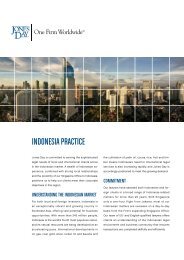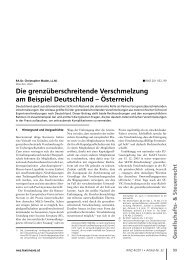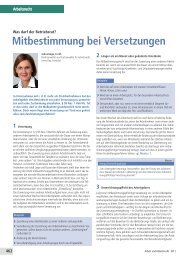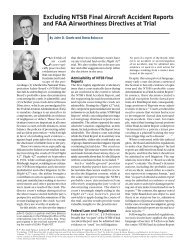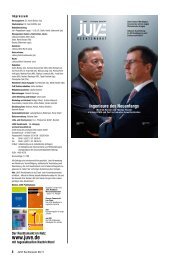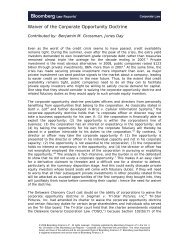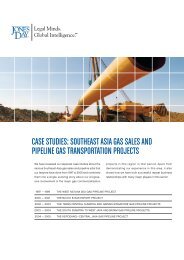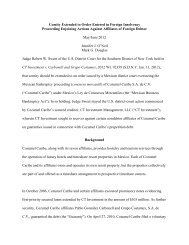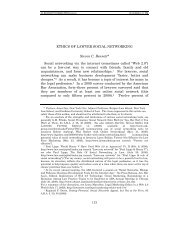Is Your Pillow a Pesticide? - Jones Day
Is Your Pillow a Pesticide? - Jones Day
Is Your Pillow a Pesticide? - Jones Day
You also want an ePaper? Increase the reach of your titles
YUMPU automatically turns print PDFs into web optimized ePapers that Google loves.
Fall 2010 What’s In Store<br />
<strong>Is</strong> <strong>Your</strong> <strong>Pillow</strong> a <strong>Pesticide</strong>? The EPA<br />
Steps Up Enforcement of Antimicrobial<br />
Advertising<br />
by Danielle M. Hohos<br />
Danielle is an associate in the Washington, D.C. office of<br />
<strong>Jones</strong> <strong>Day</strong>. Her practice focuses on false advertising<br />
and consumer protection matters, in addition to general<br />
litigation. The author would like to thank Emily A.<br />
Posner, an associate in <strong>Jones</strong> <strong>Day</strong>’s New York office and<br />
Mariya Nazginova, a summer associate in <strong>Jones</strong> <strong>Day</strong>’s<br />
New York office, for their assistance in researching and<br />
drafting this article.<br />
Introduction<br />
Marketers and manufacturers beware. The products<br />
you advertise as “antibacterial” or “germ resistant”<br />
may be considered “pesticides” by the U.S.<br />
Environmental Protection Agency (EPA), and<br />
subject to registration and regulation. Samsung<br />
recently paid over $200,000 in fines because the<br />
EPA declared that its computer keyboards,<br />
advertised as “inhibiting germs,” were “pesticides,”<br />
which had not been properly registered with the<br />
EPA. 1 Target paid over $40,000 to settle allegations<br />
that it sold unregistered pillows, mattress pads, and<br />
toilet seats(!), which according to the EPA were<br />
“pesticides” because the advertising stated that these<br />
products could kill germs. 2 Under the Federal<br />
Insecticide, Fungicide, Rodenticide Act (FIFRA),<br />
products that claim to kill or repel bacteria or germs<br />
are considered pesticides, and must be registered<br />
with the EPA prior to distribution or sale. In<br />
addition, marketers must have substantiation for<br />
these types of “antimicrobial” claims to satisfy the<br />
registration process. Failure to do so, as a number<br />
of consumer marketers have learned, can result in<br />
substantial penalties. 3<br />
The EPA’s enforcement of antimicrobial advertising<br />
claims has increased significantly in recent months.<br />
In May 2010, the EPA settled with four<br />
manufacturers, who paid a total of over $500,000 to<br />
resolve cases involving unsubstantiated<br />
antimicrobial claims. Califone International, Inc.,<br />
which claimed that its headphones prevented “the<br />
spread of bacteria, mold, and mildew for student<br />
protection,” was assessed a $220,000 fine. 4 The<br />
maker of North Face shoes also paid over $200,000<br />
for making allegedly unsubstantiated “antimicrobial<br />
protection” claims. 5 EPA targets have included a<br />
host of other products that would hardly be<br />
considered “pesticides” by most manufacturers, or<br />
by the consuming public: faucets, spigots, handles,<br />
light switches, garden hoses, and even a computer<br />
mouse. 6<br />
As Katherine Taylor, Associate Director of the<br />
Communities and Ecosystems Division in the EPA’s<br />
Pacific Southwest Region notes, there are “more and<br />
more consumer products making a wide variety of<br />
antimicrobial claims” and “EPA takes these<br />
unsubstantiated public health claims very<br />
seriously.” 7 Because the “EPA will take decisive<br />
action against companies making unverified public<br />
health claims,” companies should be aware of the<br />
registration process and the substantiation<br />
requirements under FIFRA. 8<br />
History of the Federal Insecticide, Fungicide,<br />
Rodenticide Act 9<br />
The regulation of pesticides is not new. The federal<br />
government first started regulating pesticides with<br />
the passage of the Federal Insecticide Act of 1910. 10<br />
Congress intended to reduce economic exploitation<br />
of farmers by outlawing the manufacturing and<br />
distribution of misbranded or adulterated pesticides.<br />
In 1947, Congress addressed the potential risks to<br />
human health posed by pesticides by passing the<br />
Federal Insecticide, Fungicide, Rodenticide Act. 11<br />
FIFRA broadened the federal government’s control<br />
of pesticides by requiring product label registration<br />
of all pesticides prior to their introduction in<br />
interstate commerce. Moreover, Congress placed<br />
the burden of documenting a pesticide product’s<br />
efficacy and safety on the manufacturer. The 1964<br />
amendments to FIFRA authorized the Secretary of<br />
Agriculture to refuse registration to pesticides that<br />
What’s In Store Volume 15, No. 2, Fall 2010 12
Fall 2010 What’s In Store<br />
were deemed unsafe or ineffective and to order their<br />
removal from the market. 12 At this point, however,<br />
the reach of FIFRA extended only to traditional<br />
“pesticides,” such as those used for agricultural<br />
purposes.<br />
After the establishment of the EPA in 1970,<br />
Congress transferred the administration of FIFRA<br />
from the USDA’s Insecticide Board to the newly<br />
created EPA by passing the Federal Environmental<br />
<strong>Pesticide</strong> Control Act (FEPCA) in 1972. 13 FEPCA,<br />
largely still in place, significantly transformed<br />
FIFRA and turned it from a labeling statute into a<br />
comprehensive scheme for regulating the<br />
distribution, sale, and use of pesticide products.<br />
Among these changes, FEPCA specified methods<br />
and standards of control for the registration process<br />
in greater detail, required all persons who apply<br />
pesticides to follow all label directions, classified<br />
pesticides for restricted use or general use, and<br />
obligated states to adopt parallel laws. 14 Moreover,<br />
the statute authorized the EPA, as the Administrator,<br />
to take enforcement actions against manufacturers<br />
and retailers claiming that their products contain<br />
antimicrobial properties or making other public<br />
health claims, without first registering the product as<br />
a pesticide and submitting the required efficacy data<br />
to the agency. Subsequent amendments have further<br />
clarified the statute, as well as the duties and<br />
responsibilities of the EPA. 15 The most recent<br />
amendments to FIFRA occurred in 1996 with the<br />
Food Quality Protection Act. 16<br />
How FIFRA Works<br />
Generally, FIFRA is a regulatory statute which<br />
requires registration of pesticide products and<br />
pesticide-production facilities, as well as proper<br />
pesticide labeling. Under FIFRA, no one may sell,<br />
distribute, or use a pesticide unless it is registered by<br />
the EPA, or it meets a specific exemption as<br />
described in the regulations. FIFRA defines a<br />
pesticide as “any substance or mixture of substances<br />
intended for preventing, destroying, repelling, or<br />
mitigating any pest.” 17 Further, a “pest” is defined<br />
as “(1) any insect, rodent, nematode, fungus, weed,<br />
or (2) any other form of terrestrial or aquatic plant or<br />
animal life or virus, bacteria, or other microorganism<br />
(except viruses, bacteria, or other microorganisms<br />
on or in living man or other living<br />
animals). . .” 18 In other words, products are subject<br />
to FIFRA if they contain claims that they are<br />
antibacterial or germicidal (“germ-resistant”). An<br />
“antimicrobial pesticide” is defined as one that “is<br />
intended to (i) disinfect, sanitize, reduce, or mitigate<br />
growth or development of microbiological<br />
organisms; or (ii) protect inanimate objects,<br />
industrial processes or systems, surfaces, water, or<br />
other chemical substances from contamination,<br />
fouling, or deterioration caused by bacteria, viruses,<br />
fungi, protozoa, algae, or slime”; and that is not<br />
subject to a food additive regulation or a pesticide<br />
tolerance under the Federal Food, Drug, and<br />
Cosmetic Act. 19 Thus, products making<br />
antimicrobial claims are generally subject to FIFRA<br />
requirements. 20<br />
Registration and Labeling of Products<br />
All pesticides, including antimicrobials, must be<br />
registered with the EPA and must have the<br />
appropriate scientific data, including testing results,<br />
necessary for their registration. Generally, there are<br />
six types of pesticide registrations: unconditional<br />
registrations, conditional registrations, supplemental<br />
registrations, state special local needs registrations,<br />
restricted use pesticides, and emergency exemptions<br />
from registration. 21 The type of registration granted<br />
is dependent on the toxicity and behavior of the<br />
product in the environment. 22 Manufacturers are<br />
required to conduct studies and compile data about<br />
the product, including the product’s chemistry and<br />
hazards to humans. 23 The type of data and/or<br />
studies required depends on the type of registration<br />
being requested. The information submitted by the<br />
manufacturer is reviewed, along with information<br />
compiled by the EPA and the EPA decides whether<br />
to register the product, whether the pesticide would<br />
present an unreasonable risk to human health or the<br />
environment, and what type of registration, if any,<br />
will be granted to the pesticide. 24<br />
What’s In Store Volume 15, No. 2, Fall 2010 13
Fall 2010 What’s In Store<br />
Registration also includes the EPA’s approval of the<br />
pesticide product’s labeling, including advertising<br />
claims incorporated in the label. 25 The Agency<br />
reviews a pesticide product’s labeling and informs<br />
applicants or registrants if the Agency finds specific<br />
statements, claims, product brand names, logos,<br />
pictures, or other aspects of the labeling to be<br />
potentially false or “misbranded.” 26 Such statements<br />
cannot be used. Examples of misbranding include:<br />
A false or misleading statement concerning<br />
the composition of the product;<br />
A false or misleading statement concerning<br />
the effectiveness of the product as a pesticide<br />
or device;<br />
A false or misleading statement about the<br />
value of the product for purposes other than<br />
as a pesticide or device;<br />
A false or misleading comparison with other<br />
pesticides or devices;<br />
Claims as to the safety of the pesticide or its<br />
ingredients, including statements such as<br />
“safe,” “nonpoisonous,” “noninjurious,”<br />
“harmless,” or “nontoxic to humans and<br />
pets” with or without such a qualifying<br />
phrase as “when used as directed”; and<br />
Non-numerical and/or comparative<br />
statements on the safety of the product,<br />
including but not limited to: “Contains all<br />
natural ingredients” and “among the least<br />
toxic chemicals known.” 27<br />
There are also exemptions from FIFRA. 28 An<br />
article or substance, treated with or containing a<br />
pesticide, is exempt from FIFRA if: (1) the<br />
incorporated pesticide is registered for use in or on<br />
the article or substances, and; (2) the sole purpose of<br />
the treatment is to protect the article or substance<br />
itself. 29 An example of such an exemption would be<br />
treated wood—the wood is treated to protect against<br />
insect or fungus infestation. 30 Other examples<br />
include treated articles where pesticides are<br />
incorporated because of their ability to inhibit the<br />
growth of microorganisms which may cause odors<br />
or to inhibit the growth of mold and mildew.<br />
Penalties<br />
There are a number of ways that the EPA can<br />
penalize a manufacturer or distributor making<br />
unregistered or unsubstantiated pesticide claims.<br />
Once the EPA determines that a FIFRA violation<br />
has occurred, it chooses an appropriate level of<br />
enforcement response for the violation. In<br />
determining the level of action, the EPA generally<br />
considers the severity of the FIFRA violation, the<br />
company’s compliance history, and the relevant<br />
facts and circumstances of each case. 31<br />
A civil penalty is the “preferred enforcement<br />
remedy for most violations.” 32 The EPA is<br />
authorized to assess manufacturers and distributors<br />
of pesticides a penalty of up to $7,500 for each<br />
violation of FIFRA. 33 In determining the amount of<br />
the civil penalty, the EPA is required to consider the<br />
size of the business, the effect of the penalty on the<br />
person’s ability to continue in business, the<br />
economic benefit of non-compliance, and the<br />
gravity of the violation. 34 The statute also provides<br />
a civil penalty matrix to assist the Agency in<br />
computation of the final fine. 35<br />
Where the EPA has reason to believe on the basis of<br />
inspection or tests that a pesticide is in violation of<br />
any provision of FIFRA, it has authority to issue a<br />
Stop Sale, Use or Removal Order (SSURO). 36 A<br />
SSURO is generally issued against persons who<br />
own, control, or have custody of pesticides where<br />
pesticides have “labeling that is materially<br />
misleading or fraudulent and, if followed by a user,<br />
is likely to cause a significant health hazard or<br />
serious adverse environmental effect.” 37<br />
Specifically, a SSURO could be issued for labeling<br />
on products that are ineffective for the purposes<br />
claimed or that bear false or misleading safety<br />
claims. No court order or seizure of the alleged<br />
illegal products is necessary to obtain a SSURO. 38<br />
The EPA merely has to confirm that a violation has<br />
What’s In Store Volume 15, No. 2, Fall 2010 14
Fall 2010 What’s In Store<br />
occurred and it can seek civil penalties and a<br />
SSURO. 39<br />
Other options available to the EPA include seizures<br />
and injunctive relief. 40 Both procedures require the<br />
EPA to initiate action in United States District<br />
Court. 41 The EPA will initiate a seizure action in<br />
certain circumstances, including where the EPA has<br />
issued a SSURO but the company has not complied<br />
with it, or where the EPA has reason to believe that<br />
if it issued a SSURO, the company would not<br />
comply with it. 42 The EPA may opt to seek<br />
injunctive relief where there is a violation of a<br />
SSURO and a civil penalty could not provide an<br />
appropriate or timely remedy to deter further<br />
violations, or where there is continued distribution<br />
of an unregistered pesticide after the Agency has<br />
taken action against it. 43<br />
Recent Enforcement Actions<br />
The EPA’s enforcement actions have involved<br />
traditional pesticides, such as sanitizers and<br />
disinfectants, but, as noted above, they have also<br />
included products not traditionally considered<br />
pesticides such as toilet seats, shoes, and pillows.<br />
Recent enforcement actions and settlements for<br />
products not traditionally considered pesticides<br />
include:<br />
Shoes (VF Outdoor, Inc (The North Face)). In<br />
May 2010, the manufacturer of North Face shoes,<br />
VF Outdoor, Inc., paid $207,500 for allegedly<br />
making unsubstantiated claims about the<br />
“antimicrobial protection” in its shoes. 44<br />
Computer Keyboards (Samsung). In October<br />
2009, the EPA assessed a $205,000 fine against<br />
Samsung for violating FIFRA by publicizing that<br />
Samsung keyboards were antimicrobial and<br />
inhibited germs and bacteria. As explained above,<br />
Samsung’s public health claims in promotional<br />
material about the keyboards on its netbook and<br />
notebook computer laptops rendered the products<br />
pesticides. In addition to paying the fine, Samsung<br />
agreed to stop making the “pesticidal claims” and<br />
provide a certification that it complied with FIFRA<br />
by removing such claims. Additionally, Samsung<br />
agreed to notify its retailers and distributors to<br />
remove the pesticidal claims from labels,<br />
promotional brochures. and Internet content relating<br />
to the keyboards. 45<br />
Computer Accessories (IOGEAR). On March 5,<br />
2008, the EPA assessed a $208,000 fine against<br />
ATEN Technology, Inc., acting for its subsidiary<br />
IOGEAR, for violating FIFRA by selling<br />
unregistered pesticides and making unproven claims<br />
about the antimicrobial effectiveness of three of its<br />
computer peripheral products: (1) a wireless laser<br />
mouse with nano-shield coating, (2) a laser travel<br />
mouse with nano-coating technology, and (3) a<br />
wireless keyboard and mouse combination.<br />
Specifically, the company made unsubstantiated<br />
public health claims about the products’ abilities to<br />
control germs and pathogens, thereby rendering<br />
them pesticides under FIFRA. 46<br />
Toilet Seats, Mattresses, and <strong>Pillow</strong>s (Target). In<br />
September 2007, the EPA settled an enforcement<br />
action against Target, which included a $40,950<br />
penalty, for selling and distributing unregistered<br />
pesticides, in this case, antimicrobial toilet seats,<br />
mattresses, and pillows. All three products made<br />
“germ-killing” claims. As part of the settlement,<br />
Target agreed to remove the pesticide claims from<br />
the products. 47<br />
Garden Hoses (Kmart). In October 2004, the EPA<br />
fined Kmart Corporation $110,000 for selling a<br />
variety of garden hoses that claimed to inhibit mold,<br />
fungus, and bacteria growth because they were<br />
determined to be unregistered pesticide products. 48<br />
Recent enforcement actions involving more<br />
traditional pesticides include:<br />
Hospital Disinfectants (Lonza, Inc.). In July 2009,<br />
the EPA settled a pesticide enforcement action<br />
against Lonza, Inc., the nation’s largest<br />
manufacturer of hospital disinfectants, for multiple<br />
FIFRA violations. The Agency alleged that Lonza<br />
What’s In Store Volume 15, No. 2, Fall 2010 15
Fall 2010 What’s In Store<br />
made misleading claims regarding the efficacy of<br />
two of its products: (1) Saniphor No. 450, registered<br />
with the EPA as a tuberculocide, but deemed<br />
ineffective against tuberculosis, and (2) 7 Healthcare<br />
Disinfectant Neutral Cleaner, which did not<br />
effectively kill the pathogen Pseudomona<br />
aeruginosa, despite the claim as such on its label.<br />
As a result of the investigation, Lonza agreed to pay<br />
more than $550,000 in fines. Under a previous<br />
settlement in 2008, Lonza also developed an<br />
unprecedented nationwide quality-assurance<br />
program to ensure that the efficacy of disinfectant<br />
products it sells to hospitals are satisfactory. 49<br />
Fly Repellants (Eqyss International, Inc.). In<br />
September 2008, the EPA fined a horse products<br />
company, Eqyss International, Inc., $72,000 for<br />
distributing four unregistered pesticides including<br />
products that repel flies from horses, products<br />
intended to kill germs and bacteria on bedding for<br />
horses, and a product intended to prevent unwanted<br />
chewing by horses. 50<br />
Toilet Bowl Cleaners and Household Cleaners<br />
(Safeway, Inc.). In July 2007, the EPA fined<br />
Safeway, Inc. $675,000 for selling unregistered<br />
household cleaning products because the product<br />
labels claimed the products could disinfect and<br />
remove mold and mildew. The products included<br />
Safeway Heavy Duty Toilet Bowl Cleaner and<br />
Safeway Liquid Cleanser with Bleach. 51<br />
What’s Next for FIFRA and the EPA<br />
With the spread of environmental marketing and<br />
public-health marketing claims, the EPA has<br />
identified two areas of concern related to FIFRA<br />
enforcement. The first area deals with brand or<br />
company names that are false or misleading. The<br />
second deals with products that make misleading<br />
public health claims, such as antimicrobial claims.<br />
Recently, the EPA revived draft guidance originally<br />
issued in 2002 addressing products with brand<br />
names that, in a false or misleading manner, state or<br />
imply safety, efficacy, or comparative claims, or are<br />
otherwise false or misleading. 52 The 2002 guidance<br />
was never finalized and the EPA, in May 2010,<br />
reissued revised draft guidance for public review<br />
and comment on the same subject. 53 Public<br />
comments on the draft guidance were originally due<br />
on June 18, 2010, but the EPA extended the<br />
comment period to August 17, 2010. 54<br />
The purpose of the guidance is to assist<br />
manufacturers and distributors in better<br />
understanding the circumstances under which<br />
product brand names are potentially false or<br />
misleading and what kinds of corrective actions are<br />
necessary for registered products already bearing<br />
such brand or company names. 55 The draft guidance<br />
clarified that a pesticide product brand name or<br />
company name either by itself or containing or<br />
located in close proximity to a company name or<br />
trademark should not be false or misleading.<br />
Examples of such brand names include those that<br />
have the following words or phrases in the brand<br />
name or in close proximity to the brand name:<br />
“100% Pure,” “Germ-Shield,” “100% Protection,”<br />
“All-Kill,” “Safe,” “Safer,” “Safest,” “Natural,”<br />
“Non-Toxic,” “Environmentally Safe.” 56<br />
To help registrants determine whether their brand or<br />
company names, alone or in context, are permissible,<br />
registrants should: 57<br />
Review the list of words and phrases<br />
provided by the draft guidance (some of<br />
which are discussed above) against the brand<br />
names of its products in light of the<br />
regulations and guidance and take corrective<br />
action, if warranted.<br />
Review the product brand name and labeling<br />
for false or misleading statements that have<br />
the potential to directly or indirectly mislead<br />
consumers, particularly those that suggest or<br />
declare that a product is safer or more<br />
effective than another product, even if both<br />
products meet the same standards for<br />
registration.<br />
What’s In Store Volume 15, No. 2, Fall 2010 16
Fall 2010 What’s In Store<br />
Prepare and maintain the appropriate<br />
scientific research or other documentation<br />
information necessary to support the claims<br />
being made, as required by the EPA. 58<br />
Although the draft guidance has not yet taken effect,<br />
manufacturers should consider taking corrective<br />
action to prevent a future compliance problem.<br />
Corrective action can include changing or deleting<br />
words, phrases, or company names in the product<br />
brand name or using disclaimers or qualifiers. 59<br />
Once the guidance takes effect, the Agency will<br />
decide on a case-by-case basis whether a company<br />
or product name is permissible. Factors that the<br />
Agency will consider include: (a) the type of claim;<br />
(b) the severity of the false or misleading claims;<br />
(c) the degree to which the proposed<br />
qualifier/disclaimer language appears to mitigate the<br />
false or misleading nature of the words or phrases;<br />
(d) the similarity of the product brand name to other<br />
known false or misleading words or phrases; (e) the<br />
history of the product brand name, company name,<br />
or trademark; and (f) any supporting information<br />
supplied by the applicant, registrant, and distributors,<br />
such as a consumer survey. 60<br />
The other major concern of the EPA deals with false<br />
or misleading advertising and labeling of<br />
antimicrobial pesticides. 61 As discussed above,<br />
there are exemptions to the FIFRA requirements for<br />
certain treated articles and substances, but those<br />
exemptions only cover treated articles and<br />
substances bearing claims to protect the article or<br />
substance itself (i.e., treated wood). The exemption<br />
does not include articles or substances bearing<br />
implied or explicit public health claims against<br />
human pathogens. 62 Such claims have dramatically<br />
increased in recent years, as evidenced by the<br />
penalties rendered against non-traditional pesticide<br />
products discussed above, such as pillows and<br />
garden hoses. Where the claims for such products<br />
imply that the antibacterial or antimicrobial<br />
protection extends beyond the product itself and<br />
provides some benefit to a person’s health, they are<br />
not exempt from FIFRA requirements and the label<br />
and/or advertising violates the Act unless the label<br />
or claim is specifically registered as such.<br />
The guidance provided by EPA offers some<br />
examples of public health claims. 63 They include:<br />
Claims for the control of specific<br />
microorganisms or classes of<br />
microorganisms that are directly or indirectly<br />
infections or pathogenic to humans<br />
(including E.coli, streptococcus, and<br />
staphylococcus aureus).<br />
A claim of “antibacterial,” “bacterial,” or<br />
“germicidal” activity or references in any<br />
context to activity against germs or human<br />
pathogenic organisms implying public<br />
health-related protection is made.<br />
A claim to control the spread of allergens<br />
through the inhibition or removal of<br />
microorganisms such as mold or mildew.<br />
A non-specific claim that the product will<br />
beneficially impact or affect public health by<br />
pesticidal means at the site of use or in the<br />
environment in which applied. 64<br />
Where an article or substance makes a public health<br />
claim, such as those above, that implies efficacy<br />
beyond the product and to a person, the article is not<br />
exempt and must be registered.<br />
In addition to providing examples claims that the<br />
EPA considers public health claims, the EPA<br />
guidance also provided a list of claims where there<br />
is no exemption and the manufacturer or distributor<br />
must register the product as a pesticide and meet all<br />
the requirements of FIFRA. The list includes the<br />
following terms and phrases: antibacterial,<br />
bactericidal, germicidal, “kills pathogenic bacteria,”<br />
“effective against E.Coli and Staphylococcus,”<br />
“reduces risk of food-borne illness from bacteria,”<br />
“provides germ resistant surface,” “reduces risk of<br />
cross-contamination from bacteria,” “controls<br />
allergy causing microorganisms,” “improves indoor<br />
What’s In Store Volume 15, No. 2, Fall 2010 17
Fall 2010 What’s In Store<br />
air quality through the reduction of<br />
microorganisms.” 65<br />
There are certain claims, however, which the EPA is<br />
likely to consider acceptable for use with treated<br />
articles or substances. 66 Most noteworthy for<br />
manufacturers are claims involving odor<br />
resistance. 67 This includes claims such as “resists<br />
odors—this product has been treated to resist<br />
bacterial odors,” “inhibits the growth of bacterial<br />
odors,” “odor-resistant.” 68<br />
Manufacturers and distributors should review their<br />
product labels and the marketing associated with<br />
such products to ensure that they are not making<br />
public health claims without the proper registration.<br />
When in doubt, companies are encouraged to<br />
request a written opinion on the labeling and<br />
marketing of the product from the EPA. 69<br />
Conclusion<br />
Even the most unexpected products, like computer<br />
keyboards and toilet seats, can be deemed pesticides<br />
if their labels or advertising tout their antimicrobial<br />
benefits. As the EPA increases its enforcement of<br />
FIFRA violations, companies that manufacture or<br />
distribute products that claim to be “germ resistant,”<br />
“antibacterial,” or otherwise antimicrobial must be<br />
aware of FIFRA and comply with its registration<br />
and substantiation requirements where necessary.<br />
The EPA merely needs to run a simple Internet<br />
search to find examples of FIFRA violations and to<br />
begin investigating a product. The fines for<br />
violations can be substantial and can be avoided by<br />
registering a product or discontinuing claims<br />
requiring registration. An understanding that<br />
FIFRA requirements may now apply to products<br />
such as pillows and mattress pads should prevent<br />
manufacturers from losing sleep over the EPA’s<br />
enforcement positions.<br />
__________________________<br />
1 Press Release, U.S. Environmental Protection Agency (“EPA”),<br />
Claims About Keyboards Result in $205,000 Penalty for Samsung;<br />
Company Agrees to Stop Making Claims (Oct. 21, 2009),<br />
http://yosemite.epa.gov/opa/admpress.nsf/ab2d81eb088f4a7e8525735<br />
9003f5339/201d62b730b8262985257656005af84c!OpenDocument.<br />
2 Press Release, EPA, EPA Settles with Target on<br />
<strong>Pesticide</strong> Violations (Sept. 8, 2007),<br />
http://yosemite.epa.gov/opa/admpress.nsf/eebfaebc1afd883d8525735<br />
5005afd19/6d2a918df6f84d8f85257364005288cb!OpenDocument.<br />
3 See generally 40 C.F.R. Pt. 152. In addition to the EPA’s authority<br />
to regulate such statements, pesticide products are subject to the same<br />
broad requirements as all products, including the Federal Trade<br />
Commission’s Guidelines on Environmental Claims, 16 C.F.R. Pt.<br />
260, and the FTC’s general authority under Section 5 of the Federal<br />
Trade Commission Act, to act against false or misleading claims.<br />
4 Press Release, EPA, “The North Face” Parent Company,<br />
“Saniguard” Marketers, and Califone Fined More Than $500,000<br />
Over Antimicrobial Claims (May 6, 2010),<br />
http://yosemite.epa.gov/opa/admpress.nsf/0/AC0C1AF162588860852<br />
5771B00561E83.<br />
5 Id.<br />
6 Id. “Recent Enforcement Actions,” at, infra, page 9.<br />
7<br />
Id.<br />
8<br />
Id.<br />
9<br />
See generally EPA, FIFRA Statute, Regulations and<br />
Enforcement (May 18, 2010),<br />
www.epa.gov/compliance/civil/fifra/fifraenfstatreq.html.<br />
10<br />
Pub. L. No. 61-152, 36 Stat. 331 (1910).<br />
11<br />
Pub. L. No. 80-104, 61 Stat. 163 (1947).<br />
12<br />
Pub. L. No. 88-305, 78 Stat. 190 (1964).<br />
13<br />
Pub. L. No. 92-516, 86. Stat. 973 (1972).<br />
14<br />
Id.<br />
15<br />
Pub. L. No. 94-140, 89 Stat. 751 (1975); Pub. L. No. 95-396, 92<br />
Stat. 819 (1978); Pub. L. No. 100-532, 102 Stat. 2654 (1988); Pub. L.<br />
No. 101-624, §§ 1491-1499, 104 Stat. 3359, 3627-32 (1990); Pub. L.<br />
No. 102-237, § 1006, 105 Stat. 1818, 1894-97 (1991).<br />
16<br />
Pub. L. No. 104-170, 110 Stat. 1489 (1996).<br />
17<br />
7 U.S.C. § 136(u) (1996); 40 C.F.R. § 152.15.<br />
18 7 U.S.C. § 136(t).<br />
19 7 U.S.C. § 136(mm)(1) (citing 21 U.S.C. §§ 346a, 348).<br />
20 See generally 40 C.F.R. § 152.10; § 152.8(a).<br />
21 7 U.S.C. § 136a(c)(5); 7 U.S.C. § 136a(c)(7); 7 U.S.C. §<br />
136a(b)(1); 7 U.S.C. § 136c; 7 U.S.C. § 136p.<br />
22 Id.<br />
23 40 C.F.R. Pt. 158.<br />
24 7 U.S.C. § 136a(c)-(d).<br />
25 7 U.S.C. § 136a(c)(1)(C), (F).<br />
26 7 U.S.C. § 136(q)(1); 40 C.F.R. § 156.10(a)(5)(ii).<br />
27 40 C.F.R. § 156.10(a)(5).<br />
28 40 C.F.R. § 152.25(a)<br />
29 Id.<br />
30 Id.<br />
31 See EPA, FIFRA Enforcement Response Policy (Dec. 2009),<br />
www.epa.gov/compliance/resources/policies/civil/fifra/fifraerp1209.pdf.<br />
32 Id at 10. Civil penalties are generally used where the FIFRA<br />
violation presents an actual or potential risk of harms to humans or the<br />
environment, or would impede the EPA’s ability to fulfill the goals of<br />
the statute, and the violation was apparently committed as a result of<br />
ordinary negligence, inadvertence, or mistake. Id.<br />
33 See 7 U.S.C. § 136l; FIFRA Enforcement Response Policy, supra<br />
note 31, at 10.<br />
34 See 7 U.S.C. § 136l; FIFRA Enforcement Response Policy, supra<br />
note 31, at 15-16. Note that the EPA revised its FIFRA Response<br />
Policy in December 2009 and has not given notice of any additional<br />
revisions in the wake of other agency enforcement policy revisions,<br />
What’s In Store Volume 15, No. 2, Fall 2010 18



